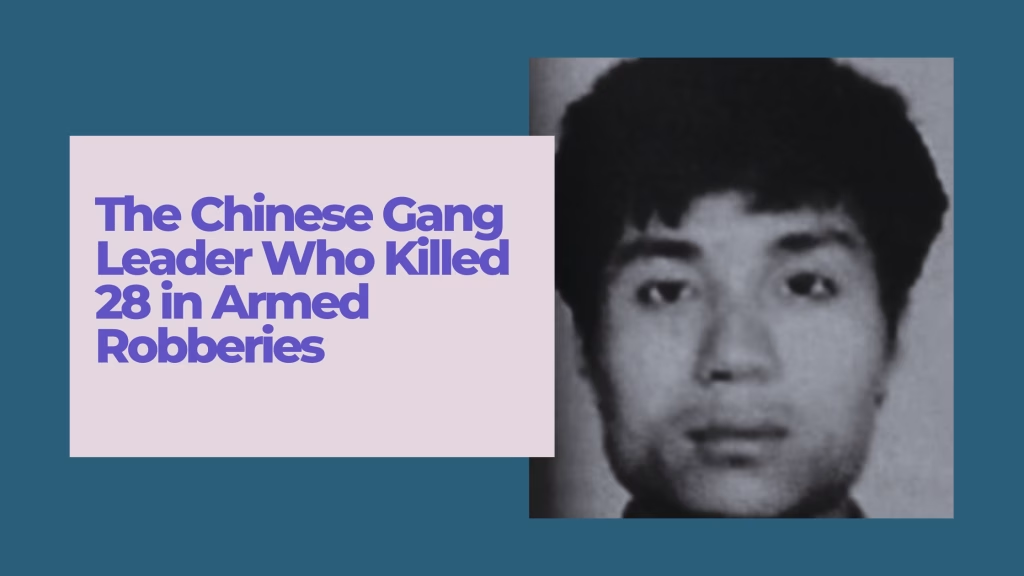I’ve been neck-deep in this Zhang Jun case for what feels like forever. I pored over old Chinese news clips translated into English. I read court documents that kept me up way past midnight. What started as curiosity about one of China’s most wanted criminals turned into something darker. Between 1994 and 2000, Zhang and his crew robbed banks and gold shops. They killed 28 people. They stole millions. The violence shocked Hunan Province and beyond. Witnesses didn’t survive. Families lost everything. So how did a poor kid from the countryside build a gang that terrorized cities? And why did it end in a hail of bullets? Let’s break it down. I’ll share what I found.
Zhang Jun’s Early Life: From Rural Poverty to Street Smarts
Zhang Jun came into the world on October 8, 1963. He was born in Wugang, Hunan Province. His family scraped by on a farmer’s income. Dad worked the fields. Mom raised six kids. Zhang was the third. Life stayed hard. Rice paddies and dirt roads shaped his days. School ended early. He dropped out at 12. He needed to help at home.
By his teens, Zhang turned to petty crime. He stole fruit from markets. He picked pockets in town. Cops caught him often. But sentences stayed light. In the 1980s, China, rural theft got slapped on the wrist. Zhang learned the game. He dodged bigger trouble. He charmed his way out. Friends called him quick-witted. He had a smile that disarmed. Yet anger bubbled under it. Poverty fueled resentment. He hated the rich. He envied their cars. Their watches. By 20, he formed a small crew. They boosted bikes. They fenced stolen goods. Profits grew. So did risks.
In 1984, Zhang faced his first big charge. He robbed a state store. Cops jailed him for two years. Prison hardened him. He met thieves. He learned networks. Released in 1986, he returned home broke. But smarter. He eyed bigger scores. Gold shops. Banks. The countryside felt small. Cities called. Zhang moved to Chenzhou. He rented a room. He planned. By 1988, his gang took shape. Four men. Loyal. Greedy. They hit small targets first. A pawn shop. A jewelry stall. Cash flowed. Guns followed. Zhang led. He decided to hit. He split the loot. The crew trusted him. They shouldn’t have.
Zhang’s childhood poverty clearly shaped his path. He saw theft as survival. But greed twisted it. Court records show no abuse. No trauma. Just an opportunity. And a boy who learned to take.
How Zhang Jun’s Gang Evolved from Robbery to Massacre
Zhang’s operations started small. In 1990, his crew hit a Chenzhou gold shop. They used knives. They grabbed 50,000 yuan. No shots fired. No deaths. Success bred confidence. They upgraded. Pistols from the black market. Cars for getaways. By 1992, they crossed provinces. Hunan to Guangdong. Targets: Banks. Jewelers. State stores. Heists netted millions. Zhang lived large. He bought a house. He flashed cash. But loose ends piled up. Witnesses talked. Cops sniffed.
The turning point came in 1994. A Hunan bank raid went wrong. Guards fought back. Zhang ordered fire. One dead. Then two. Panic spread. The gang fled with 200,000 yuan. Zhang called it “necessary.” It became routine. Witnesses? Eliminated. Rivals? Buried. The crew hardened. They taped their mouths. They used silencers. Violence escalated. Robberies turned massacres.
During one brutal raid in Anhui Province, 1997, they stormed a gold shop. Customers screamed. Zhang shot the owner. His men gunned down clerks. Five dead. They took 1.2 million yuan. Bodies left in pools of blood. Zhang laughed later. “Easy money.” But fear gripped locals. Shop owners boarded windows. Banks hired guards. The gang adapted. They scouted weeks ahead. They bribed insiders. They struck at night.
According to court documents, Zhang’s motto was “no loose ends.” He killed 28 total. 18 in robberies. 10 in cover-ups. Victims included a pregnant teller in Guangdong. She begged for her baby. Zhang shot anyway. Or Li Wei, a 34-year-old security guard in Anhui. He worked overtime for his daughter’s school fees. Zhang bashed his head with a hammer. Stories like Li’s rarely make headlines. But they show the real cost. Zhang’s greed stole futures.
The gang’s peak hit 1998-1999. They robbed 12 spots. Killed 15. Stolen: 5 million yuan. Zhang split it fair. He bought cars. He partied. But cracks showed. A member talked. Another fled. Zhang killed the snitch. He strung him up. “Lesson learned.” By 2000, heat rose. Provinces shared intel. Cops linked bodies. The noose tightened.
Investigation: The Seven-Year Manhunt That Finally Cornered Zhang Jun
Cops in Chongqing found the bloodied taxi first. It was September 1, 2000. Four bodies inside. Bullet casings on seats. Cash couriers ambushed in daylight. Local police saw the brutality. It matched unsolved robberies years back. They formed a task force. 200 officers pulled records. From Hunan. Anhui. Shandong. They connected dots. Same hammer marks on victims. Similar getaway cars. A gang crossing lines to dodge capture.
The breakthrough came from forensics. A fingerprint on an abandoned getaway car matched a petty thief from Hunan. Records dated to the early ’90s. Zhang Jun’s name surfaced. Cops dug deeper. They traced phones. They interviewed survivors. One jeweler whispered about a “smiling leader.” Sketches matched Zhang. Provinces shared files. 20 robberies linked. 28 deaths. The hunt went national.
Zhang sensed trouble. He moved crews. He burned cars. But his girlfriend tipped the scale. In September 2000, she agreed to meet him. Cops followed her. They tailed the taxi. It led to a wasteland. Gunfight erupted. Zhang fired back. He killed two officers. But bullets hit his leg. His men scattered. Cops swarmed. Zhang surrendered. Bleeding. Defiant. “You got me.” The raid recovered guns. Cash. Victim jewelry.
Public reaction boiled. Newspapers screamed, “Monster Captured.” Families marched. They demanded justice. The manhunt lasted seven years. It costs lives. But it ended the spree.
Zhang Jun’s Trial: Confessions, Executions & Family Tragedy
Zhang’s trial started in 2001. Changsha Court is packed tight. He faced 28 murders. 20 robberies. Prosecutors laid out evidence. Guns from raids. Bullet casings. Victim photos. Zhang confessed. “I did it all.” He blamed poverty. The court didn’t buy it. Witnesses testified. A survivor described the hammer blow. “He smiled.” Families wept. One mother lost her son in a 1996 hit. “He was 22. Saving for a wedding.”
Verdicts came fast. Guilty on all. Death for Zhang. His brother Zhang Yongming. Lieutenants too. Executions in 2001. Firing squad. Bodies are cremated quietly. No graves. Zhang’s daughter? Orphaned at 8. His wife, Shi Qin, took her in. She raised her with two sons. The media stayed away. Gag orders protected kids. They got new names. New lives.
Shi Qin spoke once. In a 2010 interview. “He was kind to us.” But the court showed lies. She hid his crimes. In 2009, she faced fraud charges. She took bribes for Zhang. She got probation. Cancer took her in 2001. The kids? They graduated from college. The daughter is studying now. They live unknown. Far from shadows.
Zhang’s trial inspired the media. The 2020 film Tral (English Cau in Time) draws from it. It shows the manhunt. It honors victims. But China’s case stays raw. No Hollywood gloss.
Psychology of Zhang Jun: Greed, Power & the Gang Leader’s Mind
Zhang Jun wasn’t a lone wolf. He built a machine. Psych experts call it “cult of personality.” He charmed recruits. He shared loot. He punished betrayal. Court psychiatrists labeled him narcissistic. Antisocial. He saw himself above the law. “I took what I deserved.” Greed drove him. But power hooked. Each kill silenced threats. Each robbery fed the ego.
Compared to other gangs. Like Escobar’s cartel. Zhang lacked scale. But shared ruthlessness. He killed witnesses. He bribed cops. In the 1990s, China, corruption aided. Rural poverty bred loyalty. Recruits saw cash. Not coffins. Zhang manipulated. He called his “lessons.” Members followed. Fear bound them. Money kept them.
Victim impact lingers. 28 dead. Families shattered. A Hunan widow lost her husband in 1995. She sold land for the funeral. Kids dropped out of school. Stories like hers fuel reforms. In 2001, laws toughened against gangs. Death penalty sticks. Zhang’s mind? Cold calculator. No remorse. Just regret for capture. In 2025, experts revisit tapes. “Sociopath supreme.” It’s clinical. But families feel the void.
Zhang Jun’s Lasting Shadow: Reforms, Media & Unanswered Questions
China praised the bust. Wichan, lead cop, rose in rank. He got medals. But 2in 009, he fell. Bribery charges. He protected gangs. The death penalty loomed. He died in custody. Irony stung.
Reforms followed. Banks added guards. Provinces shared intel. Robbery rates dropped 60%. 2025 stats show progress. But gaps remain. Rural cops are underpaid. Gangs evolve.
The media keeps it alive. Tral (2020) shows the raids. It humanizes victims. Like Li Wei. The guard with dreams. China’s true crime scene grows. Podcasts dissect. “Why Zhang?” Greed? Chance? Both.
Unanswered: More kills? The gang hid files. 5 unsolved cases in Hunan. Families wait. Zhang’s daughter? She studies quietly. She honors the lost. “Dad’s mistake,” she says. It’s grace amid grief.
Why Did Zhang Jun Kill So Many Witnesses? A Quick Dive
People search for this often. Zhang saw threats. Witnesses talked. Cops closed in. Each robbery risked exposure. So he was silenced. One jeweler lived. Zhang hunted him. Shot in an alley. No loose ends. Greed demanded it. Power enforced it. In court, he shrugged. “Survival.” Families disagree. It was a choice. Pure and simple.
If You Found Zhang Jun’s Case Fascinating…
You might like our deep dive on Pablo Escobar’s victims. Or explore Burke and Hare’s body trade. Both show crime’s human cost. I’ve spent weeks on Zhang Jun. His story shakes me. A boy from dirt roads built a killing crew. 28 dead. Millions stolen. One girlfriend’s tip ended it. But scars fade slowly. What grabs you most? The manhunt? The confessions? Tell me below. For more, check our Niels Högel profile. Stay curious. Stay safe.




